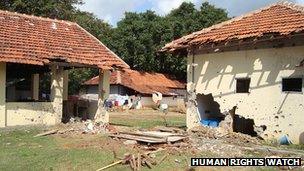Sri Lanka government publishes war death toll statistics
- Published

The civil war ended in May 2009 after goverment forces defeated Tamil Tiger rebels
Sri Lankan government statistics put the death toll in the north of the country during the final phase of the war at 9,000, the BBC has learned.
More than 7,000 of the deaths appear to be directly related to the military battle three years ago.
It is the first set of government figures given for casualties, which have been the subject of heated dispute between the government and critics.
A report commissioned by Ban Ki-Moon put the death toll at up to 40,000.
The Sri Lankan government quietly released a report by its Department of Census and Statistics over the last few days.
It contained information gathered by officials interviewing people in war-torn north of the country.
The death statistics were the most sensitive, with the report stating that in the first five months of 2009 - the climax of the war - about 7,400 people died of undefined or "other" causes.
This suggests that rather than natural causes, accident, homicide or suicide, the deaths were caused by the fighting.
The vast majority died in Mullaitivu district, the scene of the final bloody battles.
The figures also showed that more than 2,600 other people went missing throughout 2009.
It is not yet clear whether the figures include only civilians or also Tamil Tiger fighters, or which side was responsible for the deaths, but the report accords with recent Sri Lankan government admissions that its side did kill some civilians, after first saying it killed none.
The death toll figure is consistent with an early United Nations estimate, but it's much lower than the estimated 40,000 deaths given by a report commissioned by Ban Ki-Moon last year.
- Published15 February 2012
- Published23 February 2012